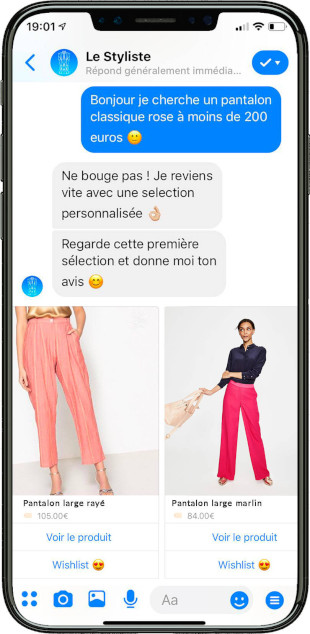We recently interviewed Samuel Sadoun, CEO of start-up Le Styliste, who has created a conversational assistant that advises and guides consumers in their online purchases by providing them with stylistic recommendations adapted to their profile. A new online way of consuming and a new channel for e-commerce brands.
Summary
- Presentation of the company
- The genesis of the idea
- Customers and partners
- The evolution of the assistant
- Key figures and prospects for the future

Presentation of the company
Le Styliste is a conversational assistant launched in 2017 by the start-up of the same name. The purpose of this assistant is to help and guide its users in their stylistic choices as well as to simplify their research and clothing purchases via the Facebook Messenger platform. Le Styliste is at the same time a conversational assistant, an advisor and above all a digital stylist accessible to everyone, everywhere, all the time, and adapted to everyone thanks to its artificial intelligence (based on recommendation algorithms): an initiative strongly linked to the changes in the retail sector.
The genesis of the idea
Initially, Le Styliste was created to serve designers on simple observation, the difficulty of making clothing purchases on the Internet. The abundance of sites makes consumer choice more complicated, and this is how the idea of offering an assistant to recommend a series of articles adapted to the users’ style and desires emerged.
It soon became clear that this niche market (creators) was more complicated than it seemed, leading Samuel to turn the business model around. The opportunity was, therefore, to develop Le Styliste on a larger scale by offering the service to all brands. In 2018, Le Styliste thus opened up to a broader audience.
To be remembered
“Service is the future of e-commerce”
After all, consumers are increasingly demanding quality services, not only in shops but also on the Internet, whether it is the customer service or the team’s availability to respond to questions or complaints.
Le Styliste’s team aims to propose a new way of consuming and shopping by incorporating more “warmth into e-commerce via dialogue”. As access to the stylist assistant is via Messenger, it is, therefore, more straight forward (no need to download yet another mobile application), which lowers the restrictions for users. Messenger also allows users to chat with Le Styliste as they would with their friends.
Customers and partners
Le Styliste is not only a robot, an artificial intelligence that generates stylistic proposals by following the desires of its customer, but also aims to be a shopping comrade. The team of the start-up supervise the system, especially during the first exchanges between the customer and the assistant, to ensure a fluid and adapted exchange for the new customer. The conversational assistant is not only adapted, but also supervised daily by Le Styliste’s team. In fact, Samuel Sadoun is aware that not everything can be automated and also points out that fashion being a very subjective and personal sector, it is not always ideal to let the robot make proposals to the users independently, especially at the beginning of the contact with a new customer (this is called the “cold start” problem in algorithm jargon). It is, therefore, necessary to continually adjust the algorithm and in some cases help it to make good suggestions by using “business rules”.

Regardless of their style and budget, which are defined in the first exchanges with Le Styliste, the algorithm offers users items from different brands, displayed on different platforms. By adding diversity to the proposals and not locking the user into the world of a single supplier, the ambition is to create a sense of trust.
70% of customers are Millennials (and this is one of the reasons for the start-up’s success with brands). Le Styliste, therefore, adopts the codes specific to this generation. The virtual assistant is on familiar terms with them, enhances the messages with emojis, in short, follows the conversational style of this segment of the population that is so well courted by companies.
The brands and sites on offer are now diversifying. Currently, the proposal covered by Le Styliste includes 60 brands and marketplaces and nearly 250,000 products. The interest is to offer customers different options and allow them to discover new brands or retailers that they might like and not just those who pay to be highlighted.
The advantage for client brands such as Asos lies in the fact that Le Styliste is perceived as an influencer since he recommends brands and articles with complete objectivity. The conversational assistant therefore not only acts as a link between the brand and the consumer but also as a marketing tool for brands and clothing websites. Indeed, the interface generates more clicks and purchases than when consumers go directly to the sites in question because it positions itself as an advisor rather than a seller. This opens up a new sales channel for brands.
The evolution of the assistant

The number of users of Le Styliste has increased from 20,000 to 60,000 over the last three months with peaks in conversation of up to 3 million messages exchanged. In February 2019, the server underwent a significant scale-up and Le Styliste’s team, victim of its success, had to slow down their communication in order not to attract even more customers. According to Samuel Sadoun, the algorithm code must be revised to allow for scale-ups and to be able to satisfy more and more customers.
The redesign of the algorithm architecture is, therefore, a priority on the start-up’s list. This adjustment should also include the improvement and diversification of the suggestions made by Le Styliste to customers on the basis of new brands (in algorithmic terms, this corresponds to the exploration criteria, which is done to the detriment of precision). The problem of “cold start” is also on the agenda for improvement since customers need suggestions that are not only relevant but also rapid right from the first use. It will, therefore, be a matter of defining the appropriate questions to be asked during the first discussion between the customer and the algorithm to make the most accurate recommendations possible.
How can the algorithm propose relevant suggestions quickly?
- By knowing the vital information from the beginning (budget, sizes, shoe sizes…)
- By receiving feedback from the customer about the proposed articles (which corresponds to explicit feedback)
- By analysing the user’s clicks and purchases (implicit feedback)
- By categorising brands, articles, and user behaviour
Key figures and prospects for the future
Le Styliste:
- 60,000 users
- 3 million messages exchanged
- 30% of users return each month
- Average shopping basket of 60€ (15% more than via the more traditional e-commerce platforms)
2019:
- to improve the algorithm (new version available mid-April 2019)
- to integrate facial recognition
- to include the tool in everyday life
2020:
- improvement of deep learning skills
- to offer the stylist assistant to everyone, even outside Messenger
- to develop the tool in new geographical markets
The team is currently composed of 13 people. The objective for 2020 is to double the workforce with technical profiles.
Posted in Innovation.